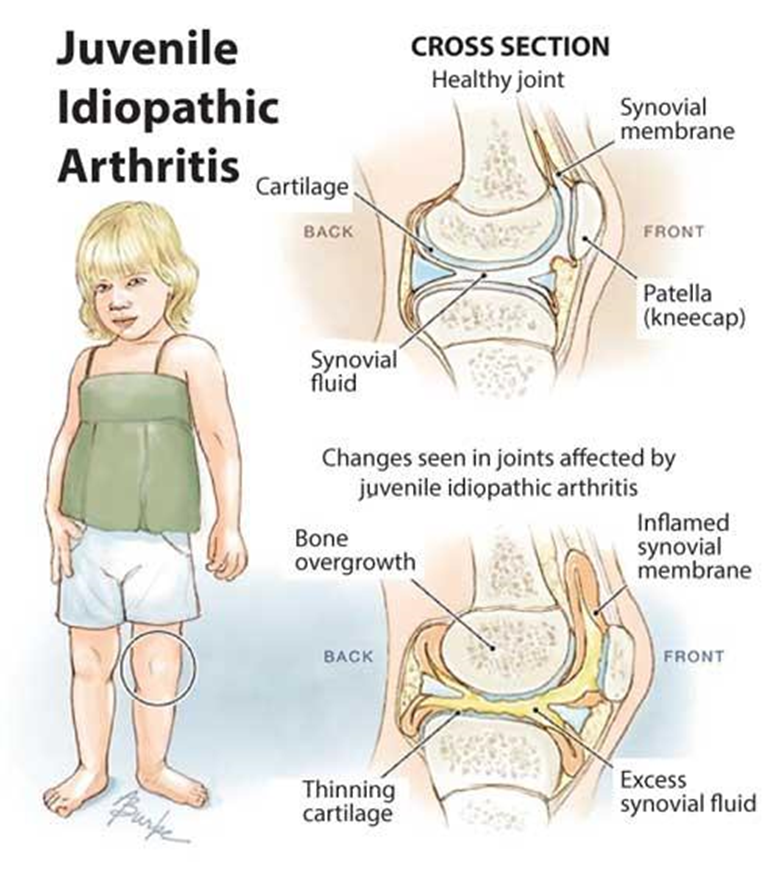A nurse is providing discharge instructions to a parent and his school-age child who has juvenile idiopathic arthritis. Which of the following
instructions should the nurse include?
Encourage the child to take a 45 min nap daily
Administer prednisone on an alternate day schedule
Apply cool compresses for 20 min every hour
Allow the child to stay at home on days when her joints are painful
The Correct Answer is B
Choice A reason: Encouraging the child to take a 45 min nap daily is not a helpful instruction, as it may interfere with the child's normal sleep pattern and school schedule. The child may benefit from regular rest periods throughout the day, but not necessarily a long nap. ⁵
Choice B reason: Administering prednisone on an alternate day schedule is a helpful instruction, as it is a common way of prescribing corticosteroids for children with juvenile idiopathic arthritis. Corticosteroids are used to reduce inflammation and control symptoms, but they have many side effects, such as growth suppression, weight gain, and osteoporosis. Giving the medication every other day may reduce some of these side effects and improve compliance. ⁶

Choice C reason: Applying cool compresses for 20 min every hour is not a helpful instruction, as it may cause skin damage and discomfort. Cool compresses may be useful for acute inflammation, but not for chronic arthritis. Warm compresses or baths may be more soothing and beneficial for the child's joints. ⁷
Choice D reason: Allowing the child to stay at home on days when her joints are painful is not a helpful instruction, as it may lead to social isolation, academic difficulties, and reduced physical activity. The child should be encouraged to attend school and participate in activities as much as possible, with appropriate accommodations and modifications if needed. The child may also benefit from physical therapy, occupational therapy, and pain management strategies. ⁸
Nursing Test Bank
Naxlex Comprehensive Predictor Exams
Related Questions
Correct Answer is ["A","B","C","D"]
Explanation
Choice A reason: This is a finding that the nurse should report to the provider. A pressure dressing is applied to the site of the catheter insertion to prevent bleeding and hematoma formation. If the dressing is saturated with bloody drainage, it indicates that the bleeding is not controlled and may lead to hemorrhage or infection.
Choice B reason: This is a finding that the nurse should report to the provider. Pulses of the extremity where the catheter was inserted should be equal to or stronger than the other extremity. If the pulses are diminished, it indicates that there is impaired blood flow to the extremity, which may be caused by arterial occlusion, thrombosis, or vasospasm.
Choice C reason: This is a finding that the nurse should report to the provider. The color and temperature of the extremity where the catheter was inserted should be similar to the other extremity. If the extremity is cool and pale, it indicates that there is inadequate perfusion to the extremity, which may be caused by the same factors as the diminished pulses.
Choice D reason: This is a finding that the nurse should report to the provider. Pain is an indicator of tissue damage or inflammation. The adolescent should have minimal or no pain after the procedure, as the site is numbed with local anesthesia. If the pain is present or increases, it indicates that there is a complication, such as bleeding, infection, or nerve injury.
Choice E reason: This is not a finding that the nurse should report to the provider. The apical pulse is the heart rate measured at the apex of the heart. It is a routine vital sign that the nurse should monitor after the procedure, but it is not a sign of a complication unless it is abnormal, such as too fast, too slow, or irregular. The nurse should compare the apical pulse with the baseline and the expected range for the adolescent's age and condition.
Correct Answer is A
Explanation
Choice A reason: This is a contraindication for the MMR immunization, which is a live attenuated vaccine. A child who has a congenital immunodeficiency may not be able to mount an adequate immune response to the vaccine and may be at risk of developing the diseases from the vaccine.
Choice B reason: This is not a contraindication for the MMR immunization. A mild fever after a previous immunization is not a sign of an allergic reaction or a serious adverse effect. The child can still receive the MMR immunization as long as they do not have a moderate or severe illness.
Choice C reason: This is not a contraindication for the MMR immunization. Taking antibiotics for otitis media does not interfere with the effectiveness or safety of the vaccine. The child can still receive the MMR immunization as long as they do not have a moderate or severe illness.
Choice D reason: This is not a contraindication for the MMR immunization. A mild cough and a low-grade fever are not signs of a moderate or severe illness that would prevent the child from receiving the vaccine. The child can still receive the MMR immunization as long as they do not have any other contraindications.
Whether you are a student looking to ace your exams or a practicing nurse seeking to enhance your expertise , our nursing education contents will empower you with the confidence and competence to make a difference in the lives of patients and become a respected leader in the healthcare field.
Visit Naxlex, invest in your future and unlock endless possibilities with our unparalleled nursing education contents today
Report Wrong Answer on the Current Question
Do you disagree with the answer? If yes, what is your expected answer? Explain.
Kindly be descriptive with the issue you are facing.
